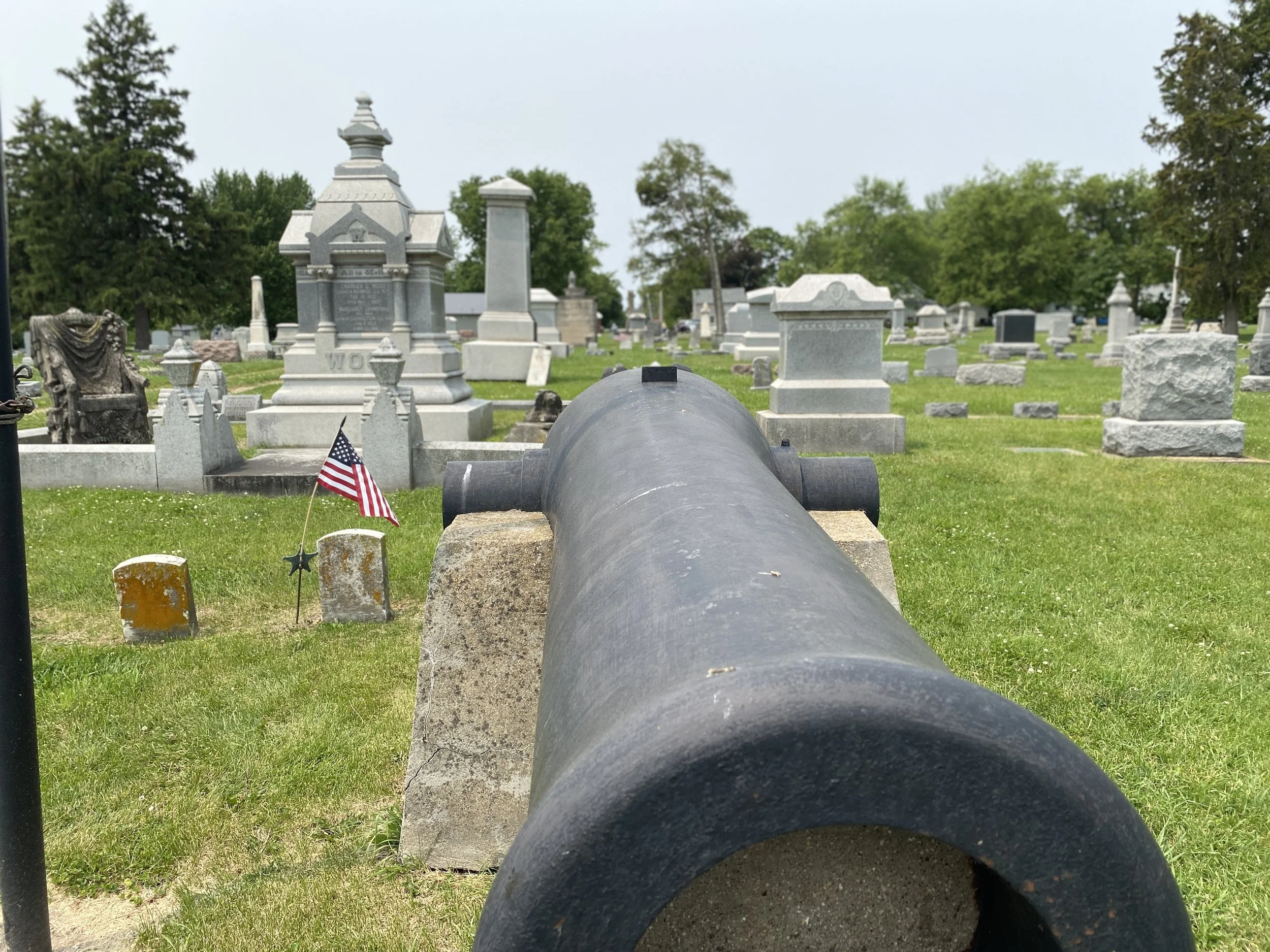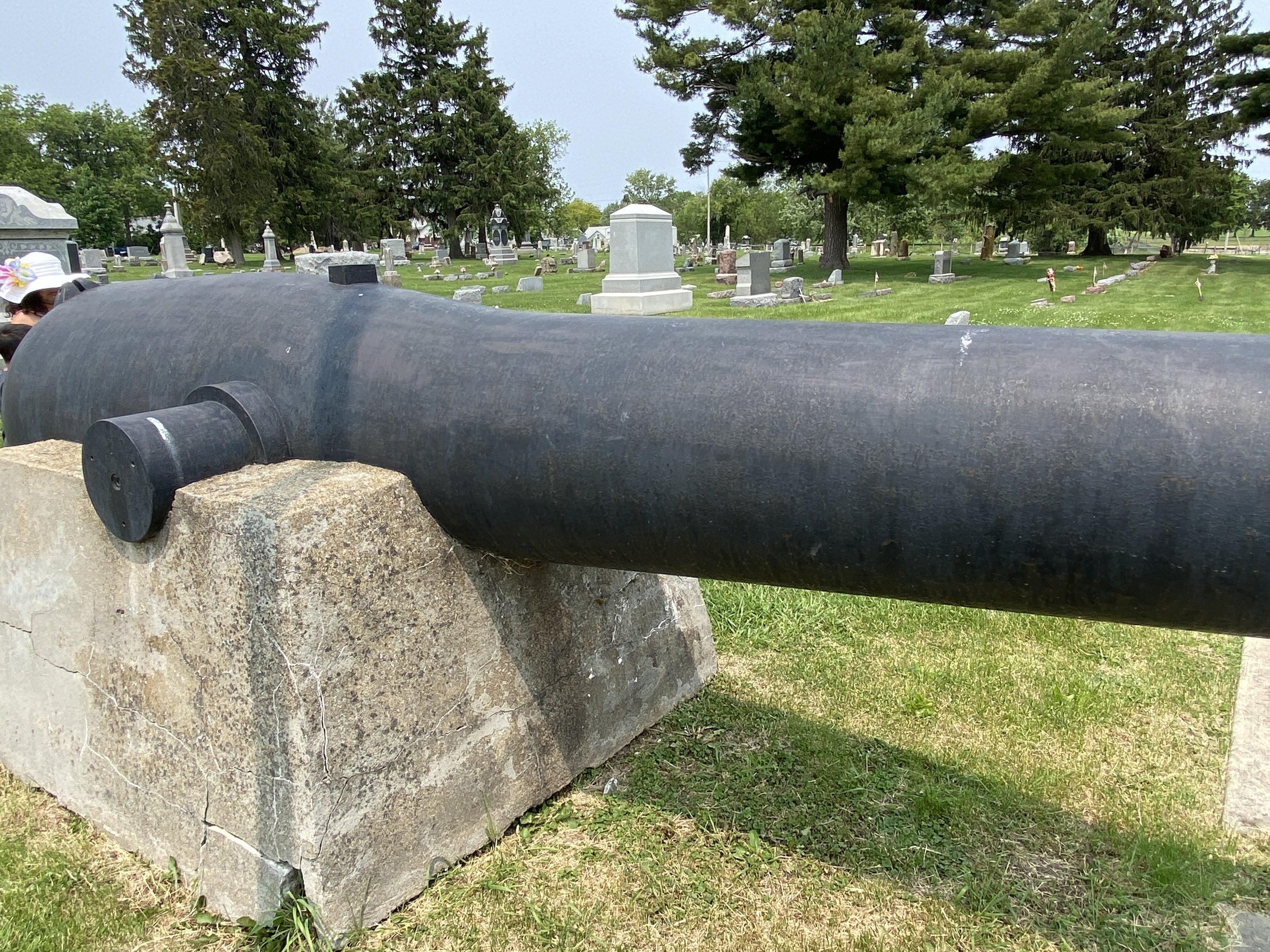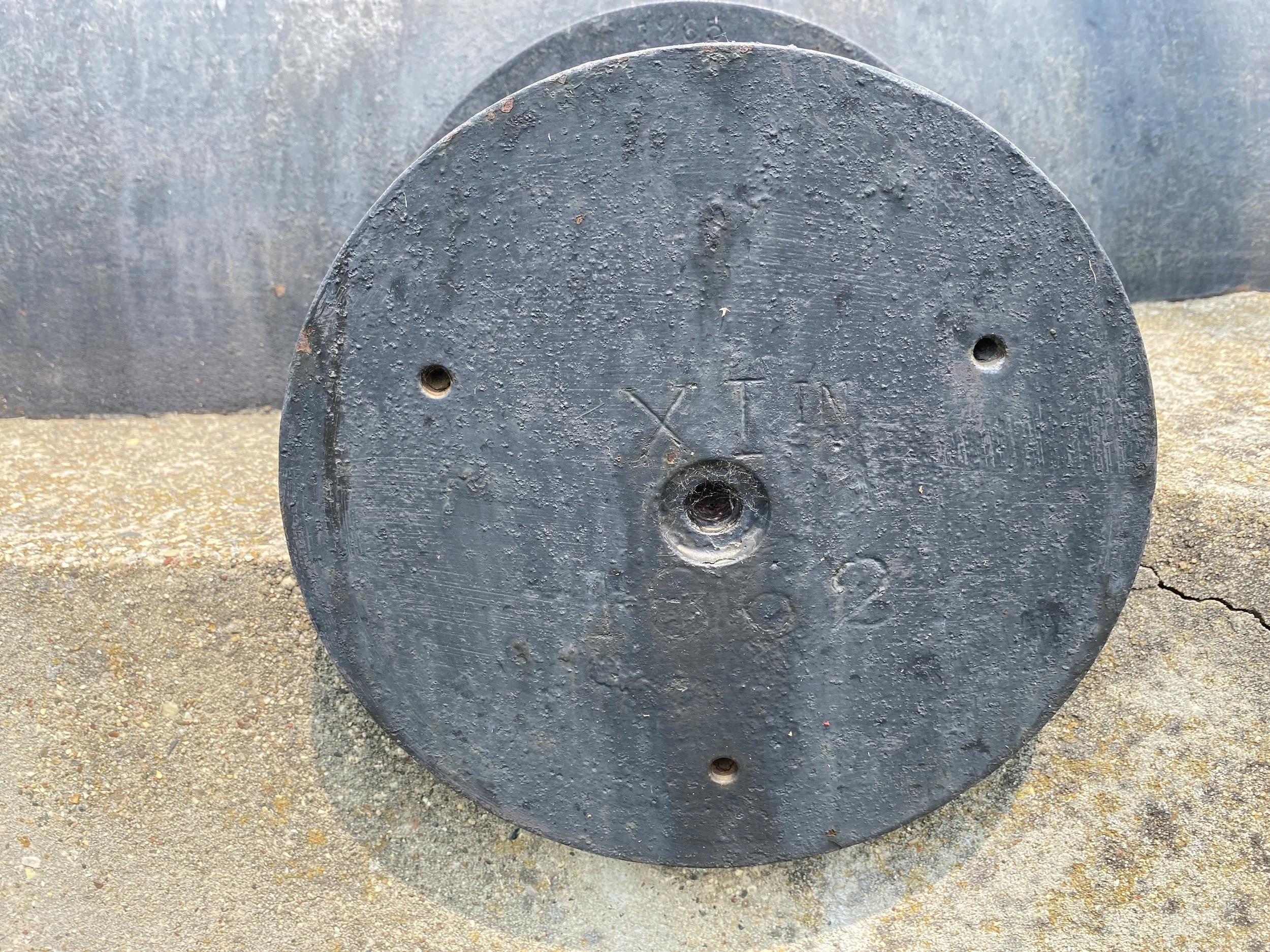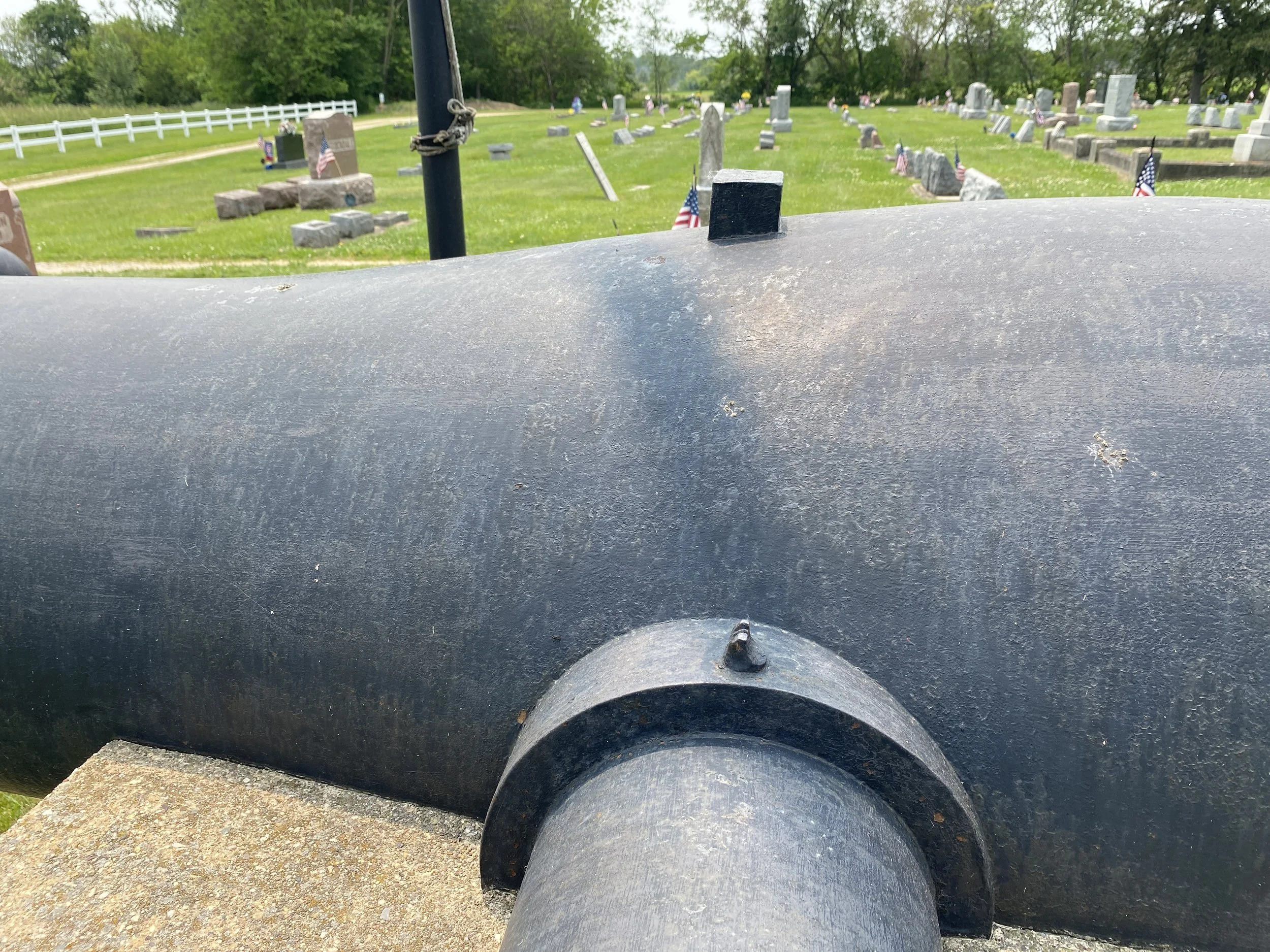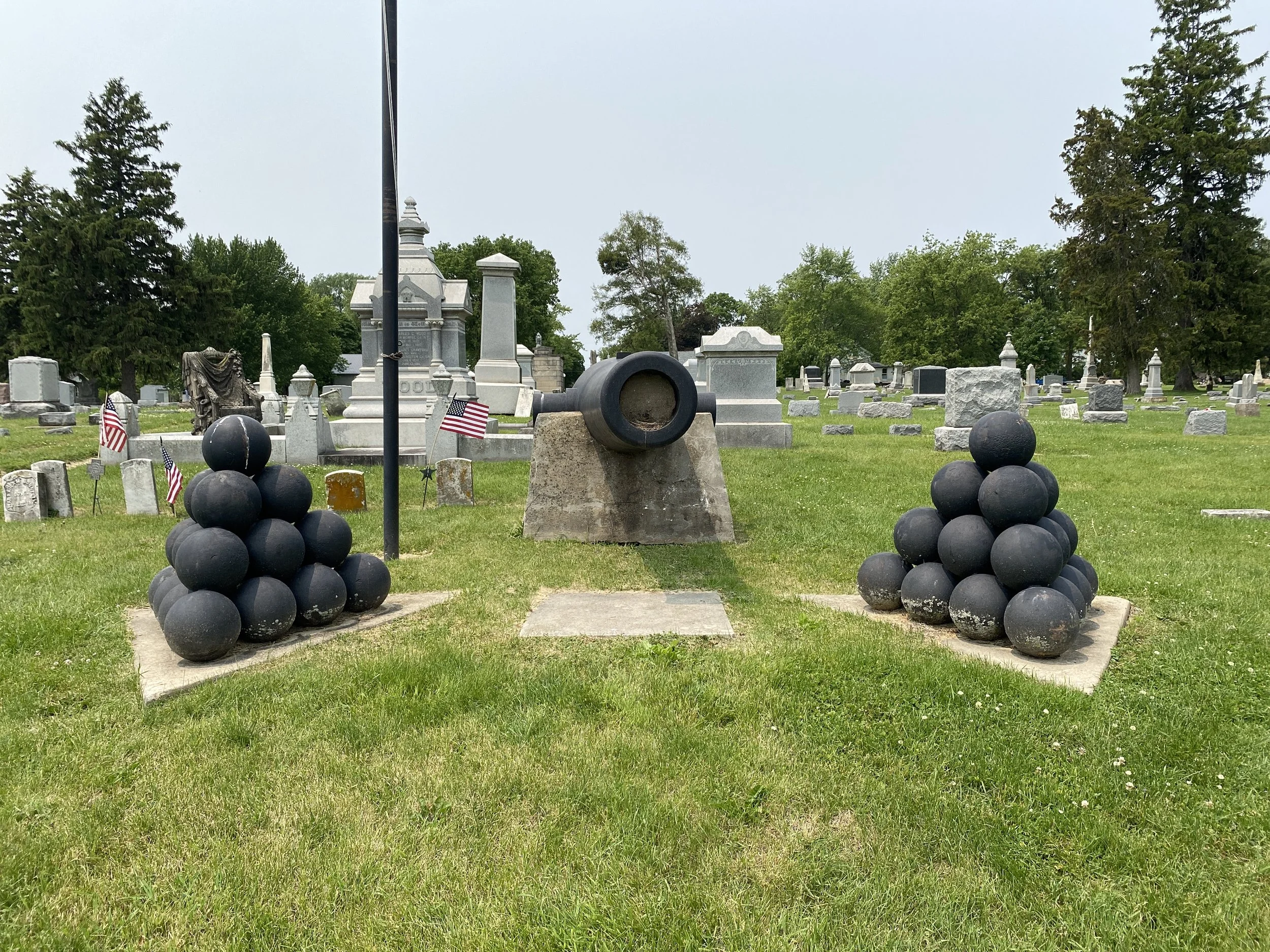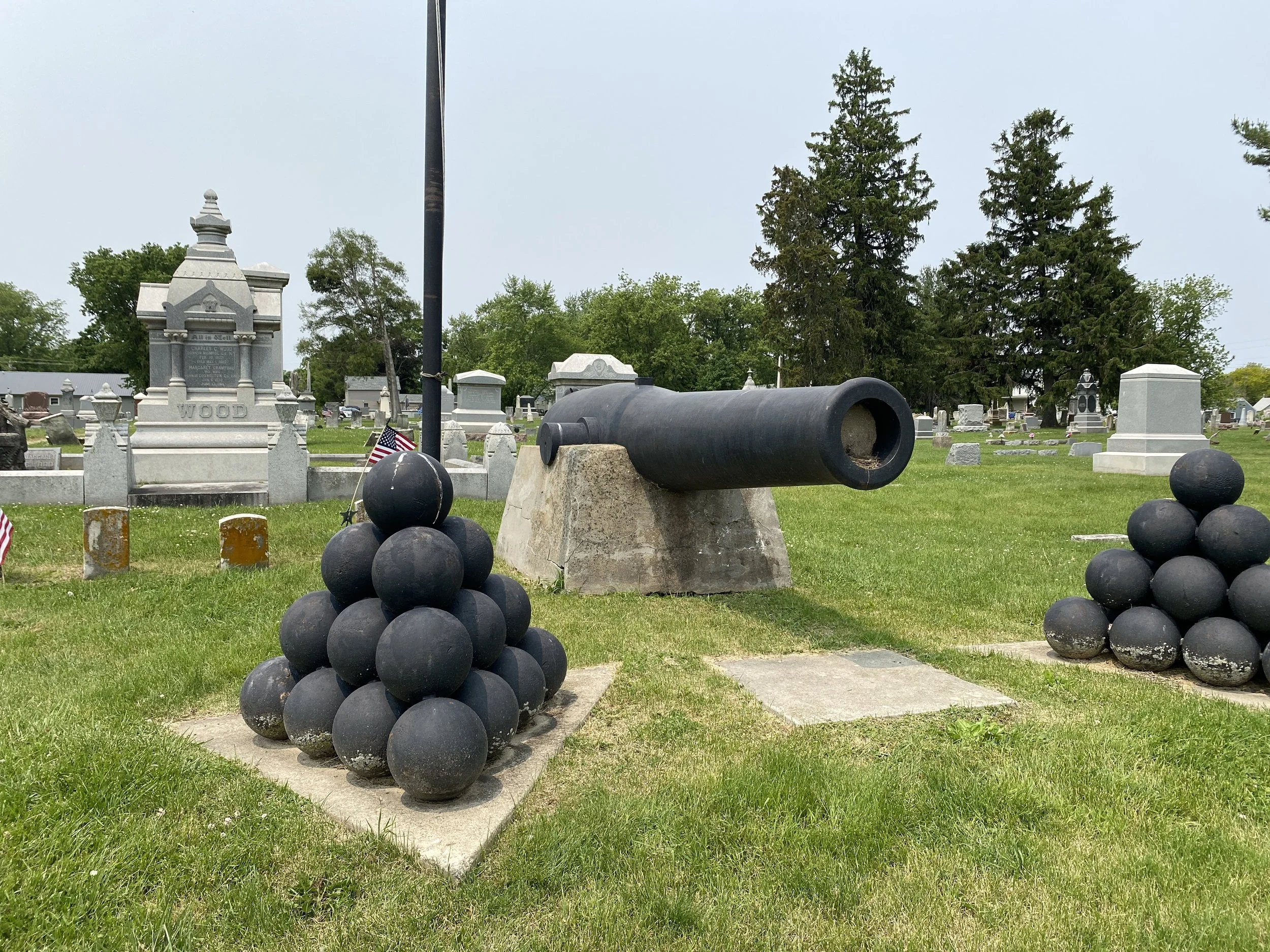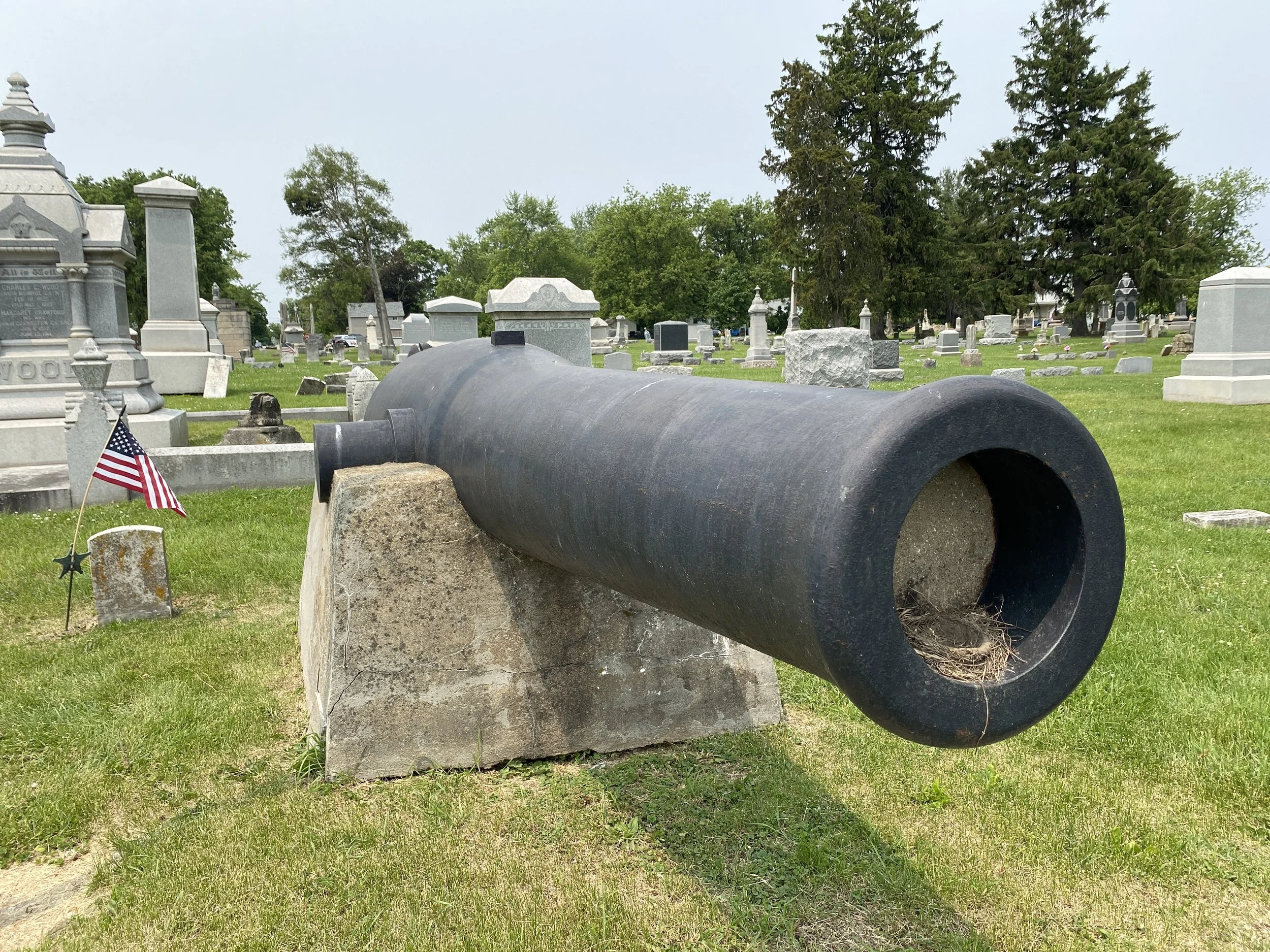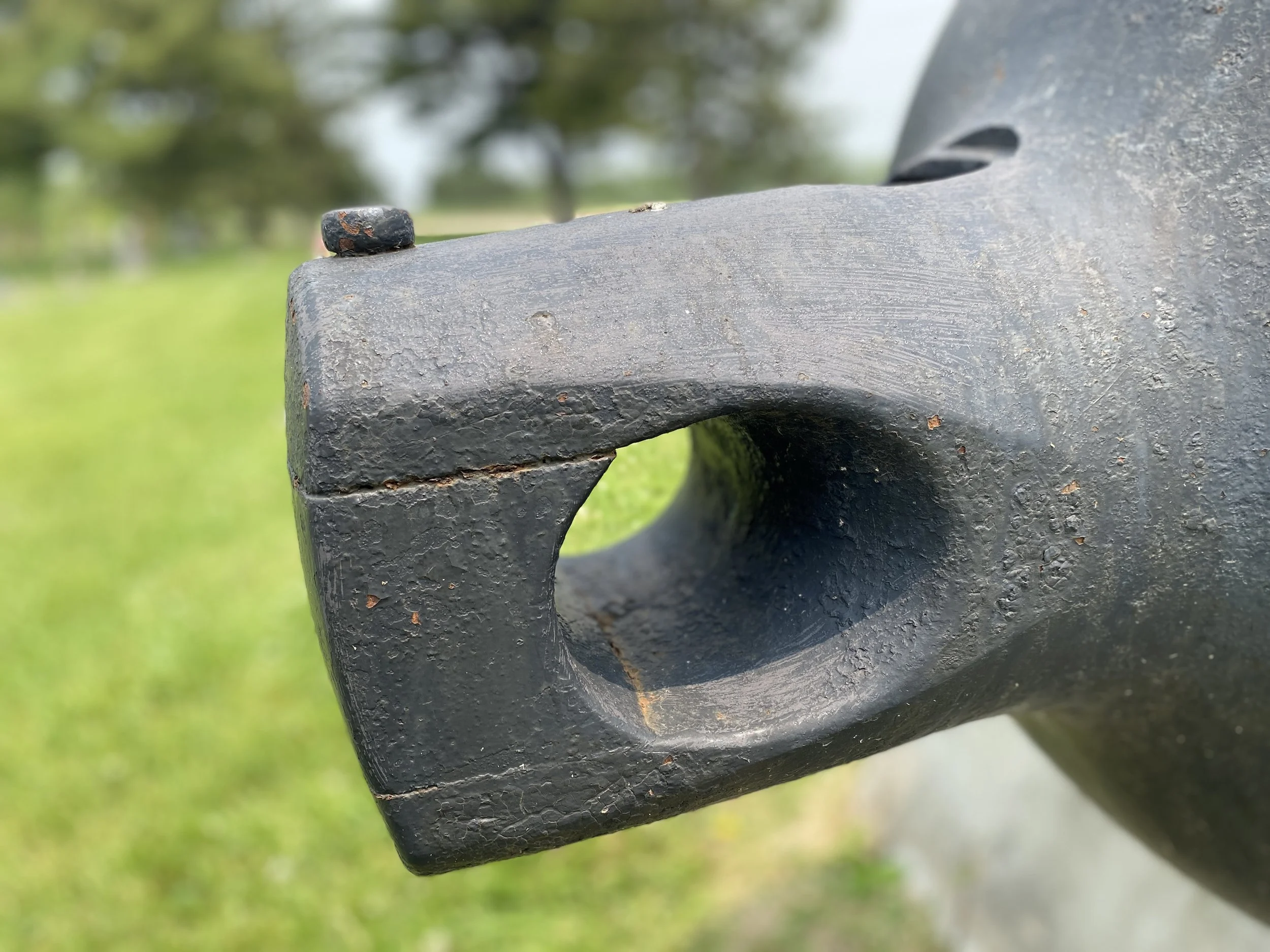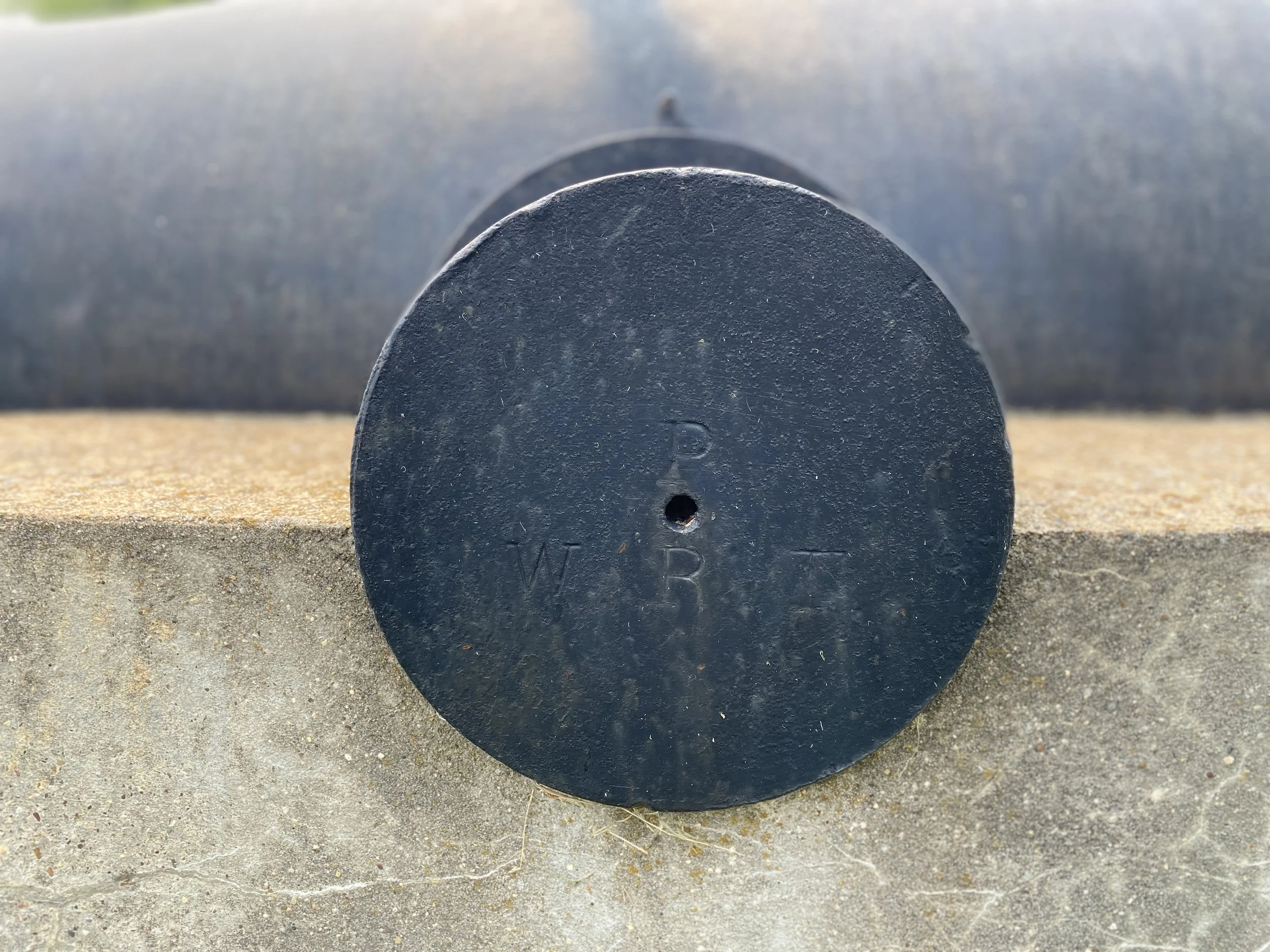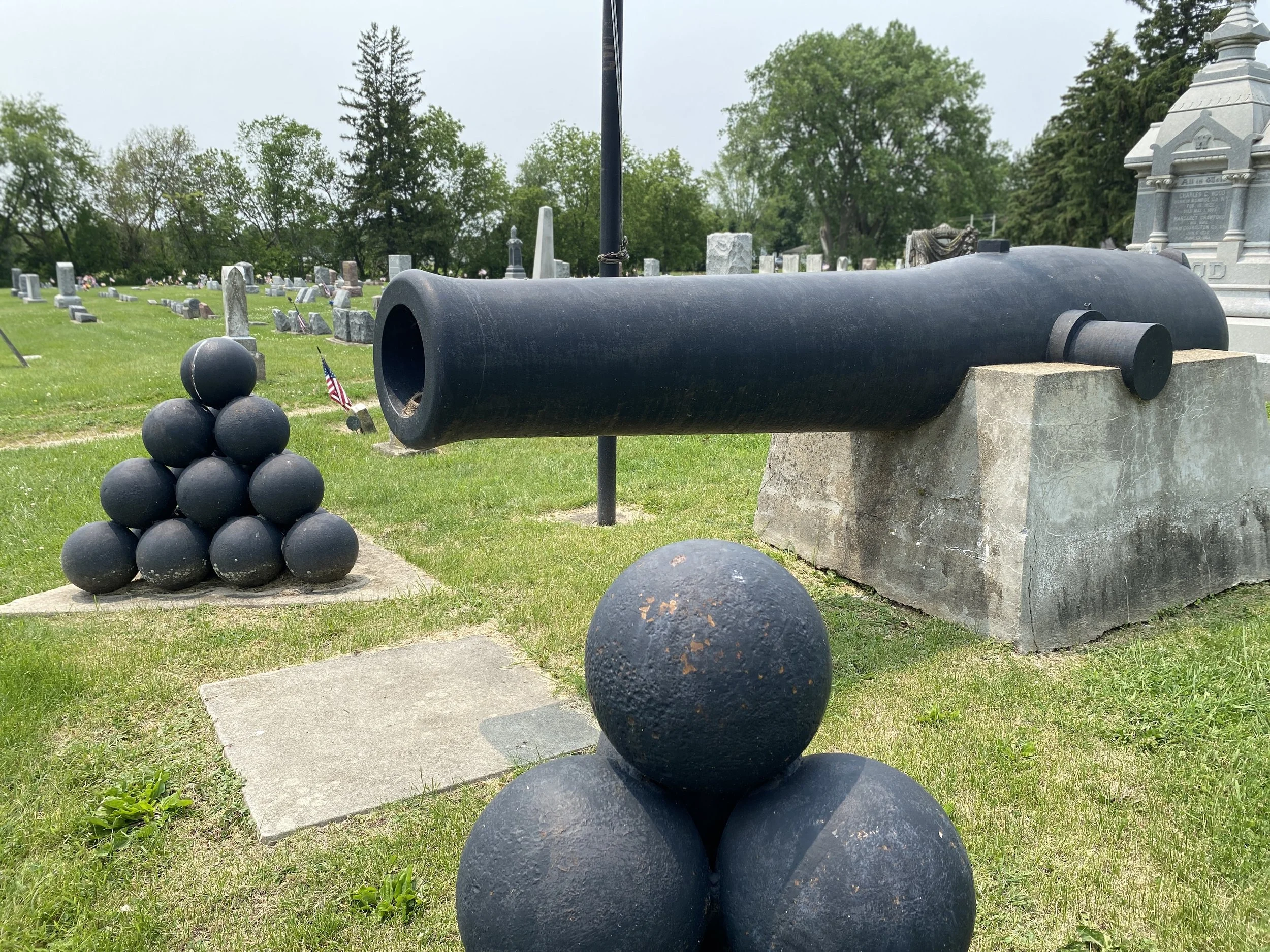USS Canadaigua’s 11-Inch Dahlgren in La Moille, Illinois
11-Inch Dahlgren Number 216 displayed at Greenfield Cemetery in La Moille, Illinois. Photo by "CistomKonfliq".
On the night of February 17th, 1864 a boat approached USS Canandaigua, a blockading sloop off of Charleston harbor. The boat contained survivors of USS Housatonic, which had just been sunk by the submarine H.L. Hunley. Captain J.F. Green of Canandaigua ordered his ship's cable slipped and he made for Housatonic. Canandaigua’s crew rescued all of the men who had taken to Housatonic's boats or clung to her rigging which remained above water. Sadly five men aboard Housatonic and all eight aboard Hunley lost their lives.
Memorial Day in La Moille, 1897
Early 1900s image of the railroad depot in La Moille, Illinois. via Wikipedia.
On Saturday, May 1st, 1897 an unusual item of freight was unloaded at the railroad depot in La Moille, Illinois. The nearly 16,000 pound cannon and fifty 135-pound, 11-inch shells had been shipped from the New York Navy Yard at a cost of $60 to the local Grand Army of the Republic Post. Under the terms of an 1896 law, a local G.A.R. post simply had to apply to the Army or Navy for an obsolete, Civil War-era cannon to be used as a monument. The cannon would be provided free of charge, though the post would be required to cover all of the “shipping and handling” charges. According to an article which appeared in the Bureau Country Tribune on May 7th, the cannon was accompanied by a document that showed its original cost to the US Navy in 1862: $1,630.14.
A May 21st article, again in the Bureau County Tribune, reported that “The La Moille folks seem very much elated over the arrival of their big gun, which will be mounted on [its] trunnions over a foundation of masonry, and will occupy a portion of the lot set aside in the soilder’s burying ground. It will be dedicated May 30th.” The writer went on to note 13-foot, six-inch, 15,765-pound size of the cannon, and he advocated that his local post “chip in” and bring a similar cannon to their community.
In the years following the American Civil War, many cities and towns erected monuments to those who had died in or served in the war. The scale and grandeur of the monuments usually corresponded to the relative wealth and size of the communities that placed them. A well-to-do community might commission a renowned sculptor to create a bespoke monument. A rural county-seat town might order a mass-produced, generic statue of a soldier. Even such modest memorials remained out of reach for smaller communities and organizations.
Prior to the 1896 law, the request of a local community for a surplus cannon from Army or Navy stores had to be authorized by a specific act of Congress. Many hundreds had been approved, but the new law simplified the process and thousands of old cannons would be shipped in the next 15-20 years. For some communities, the intention was to make an existing monument more impressive, but for many small towns like La Moille, the cannon was the only monument that could be afforded.
La Moille received an impressive cannon. It is unclear at present how much choice local communities got in which type cannon they received. The photo below shows a community in New York celebrating around a US Navy cannon which would have been only about 9.5 feet long and a mere 6,500 pounds. La Moille got a big one! In fact, the cannons in the (roughly) 16,000 pound class seem to have been among the largest that the Army or Navy sent out as memorials.
114th New York Reunion Veterans standing around a US Navy cannon likely recently placed as a memorial in Norwich, New York on May 30th, 1897. The scene in La Moille at the same time was likely very similar - except La Moille was sent a considerably larger cannon.
La Moille’s G.A.R. Post No. 66 was named after Private Parmenas L Hills, 33rd. Illinois Infantry, who had died in 1863 of wounds received in the Vicksburg Campaign. Hills is buired in La Moille at Cyrus Hills Cemetery. The post had been chartered in 1879. By 1897, all of the veterans would have been in their mid 50s or older. On Memorial Day, 1897, the veterans gathered at the Greenfield Cemetery on the southeastern side of La Moille to dedicate the huge cannon now perched on a concrete base. Surrounded by their children and grandchildren, these old soldiers and sailors would have organized a program with patriotic songs and speeches praising the virtues of those who had fought to preserve the Union during the “War of the Rebellion” and calling the young to imitate their example. According to a May 8th, 1897 article in the Champaign Daily News the program was also to include members of the National Guard and other local organizations.
In the years that followed, many of these gentlemen would find their final resting place in graves near the memorialized cannon. A 1910 report noted that the post had ten members. By 1919, Post No. 66 had closed as its last members passed away or could no longer meet. (See G.A.R. documents here and here.)
The cannon stands as their memorial. That it survives to the present is noteworthy. As many as half of those cannons placed as monuments were donated by their communities during the First and Second World Wars when the need for scrap metal seemed very pressing. The cannon in New York pictured above seems to be one of those that no longer exists.
The US Navy 11-Inch Dahlgren of La Moille, Illinois
US Navy 11-Inch Dahlgren displayed in La Moille, Illinois. Photo by "CistomKonfliq". The US Navy Registry Number 216 can be seen stamped on top of the breech of the cannon. The center block protruding in the photo is where the rear sight would have been mounted. The mounting for the forward sight can be seen towards the middle of the cannon. The blocks to either side are the mounting points for a brass hammer which was used to strike a percussion quill to fire the cannon.
The cannon at Greenfield Cemetery in La Moille is a United States Navy 11-Inch Shell Gun of 16,000 Pounds. La Moille’s 11-Inch Dahlgren is US Navy Registry Number 216. It was manufactured by Cyrus Alger & Company in 1862. As manufactured it weighed 15,765 pounds. It was proofed and inspected by US Navy officer William R. Taylor. (All of the information in this paragraph can be seen in the markings on the cannon.)
According to US Navy Ordnance Records, this 11-Inch Dahlgren served aboard USS Canandaigua. (See The Big Guns by Olmstead et al., pg. 259.)
The type was designed by John A. Dahlgren in the 1850s and therefore is usually called an “11-Inch Dahlgren.” At the time of its introduction, it was the largest and heaviest cannon in naval service anywhere. It could fire a 166-pound cannonball at a time when the cannons of most of the world’s navies fired a 32-pound ball, but it was primarily used to fire a roughly 130-pound explosive shell of the type which was sent by the navy to display alongside the cannon. A shell for this cannon resembled a “bomb” in old cartoons: an round iron ball with a burning fuse. The purpose of the cannon was to fire and embed the shell into the wooden side of an enemy ship - the explosion of such a shell could sink even the largest wooden ship if the hit was near the waterline.
In 1864, the two 11-Inch Dahlgrens of USS Kearsarge famously sank the Confederate raider CSS Alabama in the Battle of Cherbourg. Kearsarge’s two cannons are still preserved by the US Navy and are identical to the one in La Moille.
The power of shell guns to destroy wooden ships prompted the development of armored vessels - the ironclads. When USS Monitor met CSS Virginia in March of 1862 for the first battle between ironclads, Monitor carried two 11-Inch Dahlgrens in her turret - again her cannons were identical to the one in La Moille.
USS Kearsarge in 1864. Acting Master James R. Wheeler (left) and Assistant Engineer Sidney L. Smith are standing beside the ship's forward 11-inch pivot gun. The aft 11-Inch Dahlgren may also be seen in the photo. La Moille’s 11-Inch Dahlgren would have been mounted in a similar fashion aboard USS Canandaigua. Naval History and Heritage Command Photo.
Turret of USS Monitor in 1862. USS Monitor was armed with two 11-Inch Dahlgren Smoothbores. The 11-Inch Dahlgren in La Moille is identical to the two cannons of USS Monitor now under conservation in Newport News, Virginia. Library of Congress Photo. https://www.santee1821.net/preserved-artillery/the-11-inch-dahlgrens-of-uss-monitor
US Navy 11-Inch Dahlgren displayed in La Moille, Illinois. Photo by "CistomKonfliq". The protrusion at the back end of the cannon, called the “cascabel”, has a horizontal hole for a heavy rope to help check the recoil when fired and a vertical hole for a screw turned to elevate the cannon.
The right trunnion displays “XI”, indicating that this is an 11-Inch Dahlgren, and “1862”, the year of manufacture. US Navy 11-Inch Dahlgren displayed in La Moille, Illinois. Photo by "CistomKonfliq".
The left trunnion indicates that the cannon was proofed and accepted into service by US Navy Ordnance Officer William R. Taylor. Photo by "CistomKonfliq".
“C.A. & Co.” indicates that this cannon was manufactured at Cyrus Alger and Company of Boston, Massachusetts. US Navy 11-Inch Dahlgren displayed in La Moille, Illinois. Photo by "CistomKonfliq".
15,765 Pounds is the original weight of this cannon as manufactured. US Navy 11-Inch Dahlgren displayed in La Moille, Illinois. Photo by "CistomKonfliq".
The mounting point for the forward blade sight can be seen on the barrel above the trunnions. US Navy 11-Inch Dahlgren displayed in La Moille, Illinois. Photo by "CistomKonfliq".
The US Navy Registry Number for this cannon, Number 216, can be seen stamped on top of the breech. The records of the US Navy’s Bureau of Ordnance show that this cannon was carried aboard USS Canandaigua. US Navy 11-Inch Dahlgren displayed in La Moille, Illinois. Photo by "CistomKonfliq".
Additional Photos of US Navy Dahlgren Number 216 - Photos by "CistomKonfliq"
USS Canandaigua’s 11-Inch Dahlgrens: Numbers 215 and 216
USS Canandaigua in 1870. Library of Congress Photo: https://www.loc.gov/item/2016806908/
USS Canandaigua, named for a lake in New York, was a 226 foot long, wooden hulled, steam-and-sail powered ship which was built at the Boston Navy Yard beginning in 1861. She was one of six similar sloops-of-war ordered at the time which are sometimes referred to as the “Sacramento Class”. Unlike earlier ships which carried many of their cannons on broadside carriages along either side of the ship, the sloops of the Sacramento class were designed to carry three of the largest cannons on pivot mountings on the centerline of the ship. These pivot guns could be moved to fire on either side of the ship as needed.
USS Canandaigua was armed with three very heavy cannons: two 11-Inch Dahlgrens and one 150-Pounder Parrott Rifle. The 150-Pounder had an 8-Inch rifled barrel and would have weighed around 16,500 pounds. (The Parrott Rifle had somewhat greater effective range, but it was also far more prone to catastrophic explosion than the 11-Inch Dahlgren smoothbores which had an almost perfect safety record.)
Quite unusually, both of USS Canandaigua’s 11-Inch Dahlgrens still exist:
11-Inch Dahlgren Number 215 may be found at City Park in Denver, Colorado.
11-Inch Dahlgren Number 216 is in Greenfield Cemetery in La Moille, Illinois.
In service, USS Canandaigua also carried three 20-Pounder Parrotts as well as light Boat Howitzers.
11-Inch Dahlgren Number 215 of USS Canandaigua is displayed at City Park in Denver, Colorado. Photo by “Richard.”
US Army 8-Inch Parrott Rifle displayed in Waverly, Rhode Island. This cannon is nearly identical to the third “big gun” carried aboard USS Canandaigua. While the US Army kept using 8-Inch Parrotts after the Civil War, the Navy removed the type - thought dangerously unreliable - from service.
Plans of USS Canandaigua. The three circles on the top-down view of the upper deck show where the three large pivot guns were mounted. Looking at the side view, it can be seen that there are three sections of the ship’s side designed to be folded down to allow Canandaigua to fire its heavy cannons. National Archives, NARS 107-9-3A, via Donald L. Canney’s The Old Steam Navy: Frigates, Sloops, and Gunboats.
USS Canandaigua depicted in 1865 in a larger Harper’s Weekly illustration. The three large fold-down sections of the ship’s side can be seen here as her three big cannons are ready for action. Via Naval History and Heritage Command: https://www.history.navy.mil/content/history/nhhc/our-collections/photography/numerical-list-of-images/nhhc-series/nh-series/NH-59000/NH-59175.html
USS Canandaigua and Battery Wagner
US Navy ironclads off of Morris Island bombarding the Confederate forts on Morris Island and Fort Sumter as US Army soldiers watch from the beach on Morris Island, early September 1863. Library of Congress via Wikipedia.
Battery Wagner is best known for its appearance in the movie Glory where it is the objective of the heroic yet doomed attack of the 54th Massachusetts Infantry on July 18th, 1863.
Battery Wagner was located on Morris Island outside of Charleston, South Carolina. The fort, which was built out of sand, helped protect Fort Sumter from attack, and the successful reduction of Fort Sumter, and therefore - it was hoped - the capture of Confederate Charleston, depended on taking Battery Wagner as a first step. Despite the heavy casualties sustained on July 18th, United States forces continued to attempt to take the fort.
On August 17th, 1863, the ships of the US Navy’s South Atlantic Blockading Squadron, commanded by (now Rear Admiral) John A. Dahlgren began a bombardment of Batteries Wagner and Greg along with Fort Sumter. The operations were undertaken in conjunction with bombardments from US Army positions also on Morris Island. Dahlgren ordered his ironclad ships to take position relatively close to Battery Wagner while his wooden gunboats which included USS Canandaigua were to fire at the forts at long range.
USS Canandaigua’s logbook for August 17th records that at about 10 o'clock a pilot came aboard and took the ship across the shallow “bar” outside of Charleston harbor. At 11 o’clock USS Canandaigua the ship’s crew went to quarters (in later decades the crew would be ordered to “man your battle stations”.) and the ship’s heavy cannons opened fire at long range on Battery Wagner. The logbook for this day can be seen here.
The bombardments contributed to the Confederates evacuating Battery Wagner on the night of September 6-7th, 1863.
USS Canandaigua rescues the crew of USS Housatonic
Model of USS Housatonic displayed at the Charleston Museum. Model by P.C. Coker. Author’s photo.
1864 Painting of the Confederate Submarine H. L. Hunley by Conrad Wise Chapman (via Wikimedia). Hunley sank following its attack on USS Housatonic. Hunley was raised in 2000 and is now undergoing conservation in Charleston, South Carolina.
Captain Joseph F. Green, US Navy, Captain of USS Canandaigua, 1862-1864. Naval History and Heritage Command Photo: https://www.history.navy.mil/content/history/nhhc/our-collections/photography/numerical-list-of-images/nhhc-series/nh-series/NH-49000/NH-49381.html
Report of Captain Green, U. S. Navy, commanding U. S. S. Canandaigua.
U. S. S. CANANDAIGUA,
Off Charleston, S. C., February 18, 1864.
SIR: I have respectfully to report that a boat belonging to the Housatonic reached this ship last night at about 9:20, giving me information that that vessel had been sunk at 8:45 p. m. by a rebel torpedo craft. I immediately slipped our cable and started for her anchorage, and on arriving near it, at 9:35, discovered her sunk with her hammock nettings under water; dispatched all boats and rescued from the wreck 21 officers and 129 men.
There are missing, and supposed to be drowned, the following-named officers and men: Ensign Edward C. Hazeltine, Captain's Clerk Charles O. Muzzey, Quartermaster John Williams, Second-Class Fireman John Walsh, Landsman Theodore Parker.
Captain Pickering is very much, but not dangerously, bruised, and one man is slightly bruised.
I have transferred to the Wabash 8 of her officers and 49 men, on the account of the limited accommodations on board of this vessel. Very respectfully, your obedient servant,
J. F. GREEN,
Captain.
USS Canandaigua’s logbook for February 17th, 1864 showing the names of those lost aboard and saved from USS Housatonic written on the purple paper taped inside. The logbook may be viewed here: https://catalog.archives.gov/id/167162713?objectPage=125
La Moille’s Monument to Her Veterans and the Sailors of the Civil War
The 11-Inch Dahlgren cannon in La Moille, Illinois is a monument to all the United States veterans of the American Civil War including those buried nearby, soldiers like Private Parmenas L Hills who gave his life during the conflict, and, intriguingly, like Elizabeth Quinn of La Moille who served in the US Army under an assumed name.
The cannon is a monument to the sailors of the US Navy as well. It is fairly uncommon for two large cannons to survive from the same ship. Between La Moille and Denver, two large, tangible artifacts from USS Canandaigua survive - artifacts which were there for the weary days and long nights on blockade duty - with all of its dangers. And as USS Canandaigua was the rescuer of USS Housatonic’s sailors, it is a monument to the first time that a submarine sank another vessel, a horror that would become all too well known to sailors in the next century. (USS Canandaigua may have contributed to Hunley’s loss: https://www.hunley.org/top-possible-theories/)
For the cannon enthusiast - the 11-Inch Dahlgren in La Moille is one of only fourteen unmodified examples of the type still in existence.
The cannon is also a subject of an intriguing post on family history here: https://kinfolks.substack.com/p/the-mysterious-cannon
If you are in the vicinity of La Moille, stop and pay a visit to this monument and piece of history.
